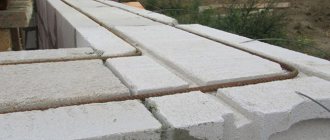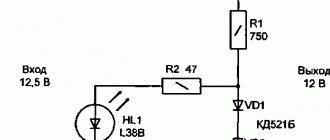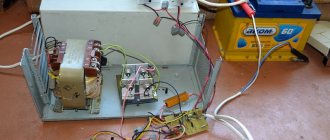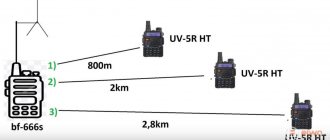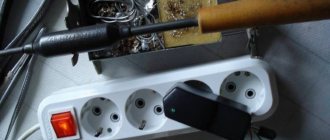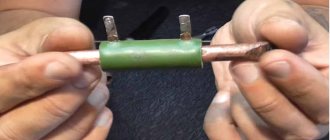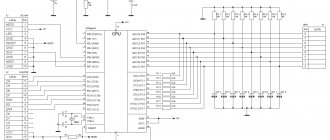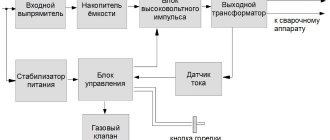What is a wall chaser
When renovating apartments, homeowners take a new approach to the placement of utility networks and various communications:
- water supply pipes;
- heating lines;
- power cables;
- sewer risers.
It is understandable that apartment owners want to place communications inside the walls and thereby improve the appearance of the premises. The technology for hidden placement of highways involves the creation of special grooves. In the vocabulary of professional builders, such channels are called grooves. For their production, a gas silicate wall chaser is used.
Wall cutter for aerated concrete. The tool began to be used relatively recently. Before its appearance, equipment was used for chiselling grooves that created vibration during operation and negatively affected the strength of building structures:
- a bolt or chisel that was struck with a hammer. The process of creating the grooves was slow and required considerable effort;
- pneumatic hammer. The tool created increased noise and significant vibration. A lot of dust was also present during the formation of the channel;
- industrial hammer drill. During the formation of cavities, vibration negatively affected the strength of concrete and caused the formation of cracks.
The use of these types of equipment required significant physical effort and was characterized by reduced productivity and increased labor intensity. Increased concentration of dust, significant noise and vibration caused a lot of inconvenience. The outdated equipment was replaced by a wall chaser for aerated concrete - a hand-held tool that has many advantages:
- reduces the duration of laying channels in walls;
- reduces the labor intensity of construction operations for gating;
- allows you to provide the necessary channel geometry in various building materials;
- provides the ability to adjust the width and depth of the cavity being formed;
- removes dust from the treated area, reducing dust concentration;
- forms a channel of the correct shape with constant dimensions along the length.
Industrial wall chaser for aerated concrete.
For one-time work, there is no need to purchase an industrial wall cutter for aerated concrete, which is quite expensive. There is a good solution - you can assemble a wall chaser from an angle grinder with your own hands. Drawings are not needed for this modernization, because the design is simple. Using available materials, you can expand the technical capabilities of home tools equipped with an aspiration system. The use of a self-made tool ensures:
- reducing the cost of plastering the groove due to the neat shape of the channel. The resulting groove does not require an increased amount of plaster;
- the ability to cut grooves in building materials with increased hardness. In this case, two cuts are performed at once in one pass.
After processing, all that remains is to remove the cut building material located between the cuts, and you can begin laying communications.
Wall chaser design
However, a wall chaser has one difference from a sanding machine. It lies in the fact that the creation of grooves occurs twice as fast as using a grinder. Moreover, using it for this purpose:
- the edges of the grooves are smoother;
- work becomes safer.
If we talk in more detail about the design of the wall chaser, we note that it is a high-power cutting machine. It is equipped with two diamond discs. The distance between them can be adjusted by a specialist.
You can also adjust the cutting depth. By varying the distance between the diamond blades, grooves of varying widths and depths can be cut. The range over which adjustment can be made varies from 3 to 40 mm.
Functions of wall chaser elements
The main element of this tool is a saw blade, which is mounted on a shaft. To ensure good safety when performing work using this tool, a special casing for diamond blades is installed. This eliminates the risk of flying fragments. When sawing, there is no chance of them hitting a person.
All models of manual wall chasers have branch pipes as part of their design. An external construction vacuum cleaner is connected to them. Thanks to this equipment, the appearance of dust in the room during work is eliminated.
This tool has a platform that is equipped with guide rollers and slides. The number of the latter can vary from 2 to 4 pieces. The platform can be installed relative to the spindle axis in a variety of positions.
When the disc is removed from the groove being cut, the slide will lower, which will lead to its fixation. This locking ensures safety when using the tool.
The ability to obtain a high quality cut is ensured by:
- The presence of a high-power engine in equipping this tool.
- High speed diamond blades.
Modern models of wall chasers use an engine as a power unit, the power of which varies from 0.8 to 2.5 kW. To increase the convenience of using this tool, it is equipped with special handles.
It’s great if the wall chaser has a slip clutch. Thanks to it, a smooth ride is ensured. It would be useful to have a wall chaser and an overheating protection system.
Another useful function that won’t hurt is brush wear control, as well as electronic overload protection. Thanks to the latter function, the tool will be able to turn off in situations where significant loads arise.
A little about gating
A groove (the term “furrow” is less commonly mentioned) consists of two parallel grooves, the width and height of the walls of which determine the possibility of installing communications in it. To make grooves, the following groove dimensions are required:
- Width from 3 to 50 mm (the first option provides for laying only power and low-current cables in the groove, the second - for installation of heating system pipes);
- The depth of the groove is no less than its width, but it is better with a small margin of 5...10 mm;
- The bottom of the groove is smooth, without protrusions.
Sometimes you have to cut inclined grooves. For oblique grooves, all specified dimensions are usually increased by 10...12%. The groove should be as even as possible, since any slope of the groove will automatically increase the length of the cable or pipe. The distance from the groove axis to adjacent ceiling structures, openings, etc. must be at least 150 mm, and to the gas pipeline elements - at least 400 mm.
The material of the walls also matters. Since the groove is obtained by removing material from under the tool disk, all dust and stone fragments fall into the worker. Even when performing such work in walls made of foam or aerated concrete, the need for dust collection is very important, since fine dust will remain in the air for a long time.
In a professional wall chaser, all these problems are solved by connecting a vacuum cleaner with a cyclone filter to the tool. Ordinary mesh ones will become clogged with gating products within a few seconds of continuous operation of the wall chaser.
The second significant difference between gating with a specialized tool is the presence of a movable frame with wheels, which, when controlled, can significantly reduce the load on the worker’s hands. A single-disc wall chaser attachment for an angle grinder does not fundamentally solve the problem, since the depth of the groove is not limited in any way, and manual removal of the jumper is very labor-intensive and does not ensure good quality of the bottom of the resulting groove. In addition, during the second pass it will not be easy to achieve parallelism of the walls of the groove.
Making a casing for an angle grinder
For one-time work, you can use primitive casings with a tube for connecting the vacuum cleaner hose. Such devices are made in a couple of hours.
When repeated use is expected or a large amount of work is required, it is worth thinking about making a more reliable design. The nozzle on the angle grinder has a complex configuration, so to make a full-fledged casing for the wall chaser you will have to weld several parts together.
For a homemade casing you will need:
- sheet iron;
- threaded studs;
- nuts for studs;
- rectangular pipe;
- welding machine.
The process begins with the manufacture of the casing itself. An old saucepan of a suitable size can serve as a blank. The walls of the pan are cut off to leave a container with sides, the height of which corresponds to the maximum width of the groove.
A hole is cut in the center of the bottom to the diameter of the standard casing of the angle grinder.
A mounting clamp is welded to the hole. A sheet of metal is welded around the clamp to increase rigidity.
Then the outer side of the casing is cut out of sheet iron and welded to the previous part.
A pipe for the vacuum cleaner hose is cut out of a piece of pipe and welded to the rounded side of the structure.
A handle pin is welded to the top side of the nozzle.
Let's start making the sole of the support platform. A rectangular pipe is cut lengthwise, cut into two parts, welded at right angles. The cheeks are welded on both sides.
The short side serves to support the body of the angle grinder, and the long side provides support against the wall.
An elongated nut is attached to the back side of the casing; a pin is screwed into it to regulate the depth of the groove. At this point, the production of the nozzle can be considered complete.
Wall chaser for foam blocks - design features
Manual tools for grooves can be manufactured in the following design options:
- based on a regular grinder. The design provides for the installation of two concrete cutting discs on the device shaft, between which a sleeve of the required length or the required number of washers can be installed. By changing the length of the spacer element, the interval between the cutting discs is adjusted, corresponding to the width of the channel;
- modernized version. It is an improved version of the grinder, on which, in addition to two circles, a casing made of metal sheet is mounted. Dust generated during the gating process is removed through a pipe attached to the metal casing of the aspiration device;
Wall chaser based on a regular grinder
- based on a hand grinder. An improved version of the tool is similar in design to a grinder with an aspiration casing. A distinctive feature of the design is the presence of a mobile platform with wheels, fixed at the bottom of the dust receptacle. This option allows you to easily move the device along the wall without applying significant effort.
An electric wall chaser for a gas block is more efficient than a manual tool due to the following points:
- increased cutting speed;
- smooth surface of the groove walls;
- clear channel geometry;
- increased security;
- aspiration possibilities.
Modern electric scoring tools include:
- protective casing. It prevents the operator from being injured by fragments when rotating the disks;
- aspiration pipe. Provides dust extraction from the work area when connected to a vacuum cleaner;
- work site. Provides smooth movement of the device along the wall and allows you to adjust the depth of the groove;
- working handle. It can be installed in various places of the casing, providing a convenient location for the device when cutting;
- electric drive. Accelerated slitting is provided with a power of 2 kW and a spindle speed of 5500 rpm.
Making a wall chaser with your own hands
The cost of a professional wall chaser ranges from 5-50 thousand/rub. Naturally, for a team of professionals or a construction company, such an amount will pay off quite quickly. But for a master doing one-time repairs in an apartment or house, such an acquisition makes no sense at all, since, apart from cutting channels, it is impossible to do anything else with a wall chaser. The best option in this case would be to make it on the basis of a regular grinder.
Preparatory stage
It is possible to produce the simplest tool for cutting channels based on an angle grinder . For this:
- A combination of standard nuts and two cutting discs is required for working with stone or concrete.
- The first disc is put on the angle grinder shaft and clamped with a standard fastening nut, which will act as a separating sleeve between the discs. Then a second disk is installed, which is secured with a nut intended for the grinding wheel.
- If the length of the working shaft allows, to adjust the distance between the disks, you can add a few more flat washers or make a separate bushing. In this case, it will be possible to cut channels of different widths.
- Naturally, when cutting with two discs, the load on the electric motor of the grinder will increase, so periodic breaks should be taken during operation to prevent it from overheating.
But when working indoors, it is still advisable to equip a handicraft wall chaser with a casing to collect dust and protect the worker from small fragments thrown out by the rotating disks.
Making a protective casing
Naturally, even with a homemade wall chaser based on an angle grinder, it’s practically impossible to do without a protective casing. In addition to protecting the worker from various fragments, the casing must have a special connection for connecting a vacuum cleaner. Various filter elements that capture dust during operation can quickly become clogged without the help of a vacuum cleaner.
If the volumes for cutting channels are small and the work is not carried out indoors, the casing can be made from waste plywood or laminated floor strips.
Such a casing, of course, will not be able to solve the problem with dust, but it will be good protection for the operator and the surrounding working area from flying fragments when cutting channels (fines).
True, with such a casing design, the cutting depth will always be the same without the possibility of adjusting it, but for channels of the same type, for example, for electrical wiring, this will be quite enough. And the plywood base will easily slide along the surface of the wall and the presence of a sled with wheels is not at all necessary.
Use of metal
Having familiarized yourself with all the elements of the wall chaser, you can freely make it yourself from metal, so that if the disk accidentally breaks or breaks, it does not injure the working operator.
A metal pan with a diameter slightly larger than the cutting disc is best suited for the casing. You will also need a sheet of metal 1.5 or 2 mm thick, a clamp for the mounting diameter of the standard protective casing of the angle grinder, a short metal pipe and a plumbing outlet, the diameter of which must match the diameter of the hose from the vacuum cleaner.
For the sole, you can use a profile pipe. To do this, you need to cut it lengthwise, and weld a frame from the resulting halves, placing the cut halves parallel to each other. to weld the halves using metal tubes through which the axles for attaching the rollers can be passed.
Then cut two sidewalls from a metal sheet and weld them to the finished frame.
After this, cut out the mount for the grinder and weld a clamp to it. To secure the clamp, you can use a hex head screw or a screwdriver.
Cut a hole in the bottom of the pan equal to the diameter of the hole in the standard casing. Then shorten the walls of the pan to a certain height and cut it below the hole.
Then you need to cut out the side from a sheet of iron and weld it to the pan opposite its bottom. But before that, a hole is also cut in it. The result is a finished casing that is welded to the sole frame.
In the almost finished casing, a hole is cut in its front part and a metal pipe from a pipe with a diameter of 40 mm for a plumbing pipe is welded. A wide nut under the handle from the grinder is welded to it. And a plumbing outlet for the hose from the vacuum cleaner is inserted into the pipe.
The pipe can also be welded to the top of the casing, and a different location can be chosen for the handle.
After the casing is completely assembled, rollers are attached to the sole , and a screw is used to set the cutting depth of the grooves.
After completing the complete assembly of the nozzle casing, it is installed on the angle grinder and fixed to it with a clamp.
After welding work and complete assembly, clean the manufactured casing-nozzle with a file from burrs and sharp corners, as well as from welding spatter. For ease of use of the vacuum cleaner, you should use a long hose, which should be at least two m/n.
Application benefits
Wall chipping is a difficult, troublesome task that takes a lot of time and effort. Previously, a variety of devices were used for such work: a chisel and chisel, a hammer drill, an angle grinder. But it is much more convenient and efficient to use a wall chaser or an attachment on an angle grinder for chasing.
So, using a specialized tool has the following advantages:
- The speed of work completion increases significantly, and labor costs are reduced.
- Can be used in conjunction with a construction vacuum cleaner.
- Work safety increases.
- It is easy to adjust the width and depth of the groove.
- The grooves are smooth, without chips or drops.
Why do you need a wall chaser?
A wall chaser is a power tool that is used to make parallel furrows or grooves. They can be of different widths and depths. What is it for? There are modern building standards according to which all communications must be laid in the recesses of the walls, and not outside. This applies to electrical cables, heating and water pipes. The exception is external wires in wooden houses. Therefore, grooves are cut in mineral materials: concrete, plaster, brick. Grooves are aesthetically pleasing, safe and are a prerequisite for repairs and construction.
Wall chaser design and functions
Structurally, this universal tool is most similar to an angle grinder (angle grinder), which in everyday life is called an angle grinder. It is widely believed that this is an angle grinder with two discs. Frankly speaking, it is almost correct. The main difference is that the wall chaser is equipped with a powerful electric motor, usually with the ability to control speed and smooth start. Good models have overheating and overload protection functions. In case of significant loads, they will allow you to save the tool.
The wall chaser uses diamond discs, the distance between them is adjusted to obtain a groove of the required width (usually up to 60 mm). For safety reasons, they are covered with a special casing. In addition, the casing has an outlet for connecting a vacuum cleaner, this allows minimizing the emission of dust during gating. To obtain the required depth, it is equipped with a special adjustable stop (usually up to 80 mm).
With the help of an attachment for an angle grinder, you can completely replace the wall chaser.
Classification of diamond blades
Wall chaser discs are not unique equipment: they can fit an angle grinder or a stationary stone cutter . In general, they are a round piece made of tool steel with a mounting hole in the center. The incisors are located on its outer surface. Diamond chips are fused into them, which do the main job of scraping out the material being processed.
Depending on the configuration of the cutting edge, which is directly related to the purpose and method of use of the tool, diamond disks for wall chasers are divided into:
- segmental;
- solid;
- turbo segment.
Each of these types has its own technical features.
Segmented drives
The main distinguishing feature of cutting wheels of this type was the presence of slots oriented in the radial direction. They divide the cutting part of the tool into several sectors, the number of which depends on the expected loads. This design ensures maximum cutting speed.
This shape makes it possible to better distribute the stresses that arise, effectively remove formed crumbs and cool the rubbing surfaces.
These discs are ideal for dry cutting of homogeneous hard materials: they are used on concrete, brick, natural and artificial stone. Diamond chips applied to the outer part of each segment do not have a viscous binding alloy, which does not allow the use of cutting wheels of this design on building parts with internal reinforcement.
Solid circles
Diamond blades of this type are shaped like a perfect circle. Their continuous cutting edge allows for extremely thin and precise cuts, even on reinforced concrete. A serious disadvantage of this design is overheating of the rubbing surfaces due to insufficient heat removal.
This consumable is only suitable for tools equipped with a cooling water supply system.
Turbo segment discs
Products of this type combine the best qualities of the first two types of cutting wheels, which makes them universal, but also the most expensive. They have a solid structure with wavy slits on the sides. With their help, effective cooling occurs and air pressure is created to remove generated dust from the groove. These blades are suitable for cutting reinforced concrete and other hard materials.
Features of choosing a tool
When there is a need to purchase such a tool, it is better to follow simple instructions:
- Select the required power of the tool. Here it is important to be guided by the amount of work ahead. Low-power wall chasers (up to 1.3 kW) are suitable for solving small household problems. Medium-power tools (1.3 kW - 2 kW) can cope with all household tasks, they heat up much less than their low-power counterparts, and their service life is much longer. It makes sense to buy powerful models over 2 kW only for regular and very large, volumetric work. In addition, the more powerful the tool, the heavier it is. This feature should also be taken into account.
- Determine such characteristics as the required maximum depth and width of the groove, the possibility of cutting the groove at an angle, the range of regulation of the electric motor speed.
- Availability of additional options: slip clutch, protection against overheating and overloads, a brush wear control system, the ability to use it in “grinder mode”, the presence of a vibration protection system.
Electric
This is a powerful tool that has two rubber rollers that help the wall chaser move easily along the wall surface being processed. This furrower is equipped with comfortable handles and several cutters that move thanks to a built-in electric motor. Designed for cutting grooves in various hard building materials.
This is a fairly simple construction tool, but its use requires certain skills and experience from the master. Also, when working with power tools, you should remember to wear personal protective equipment, as they create a lot of construction dust and noise.
Do-it-yourself wall chaser from an angle grinder
A wall chaser is a rather rare tool that not everyone has, but almost every home craftsman has an angle grinder. As already noted, structurally, these tools have a lot in common, so for home use you can easily make a wall chaser from an angle grinder with your own hands.
To begin with, it should be noted that you can use a grinder for slitting without any modifications, but it will be inconvenient, dusty and ineffective. A wall chaser is incomparably more convenient in this regard, but it is expensive. The rework will not require any special material or time costs.
We should start with the main difference - the wall chaser has two discs, and the grinder has one. It is necessary to order or grind yourself a nut with an additional ring to secure the second disk. The first disk will be secured in the usual way, and the second one directly to this nut. It is best to make several nuts of different thicknesses so that you can adjust the width of the groove. It is necessary to pay attention to the length of the shaft; it should be enough to mount two disks. It may be necessary to purchase or manufacture an extended shaft. Read about how to make a casing for connecting a vacuum cleaner here.
The second stage is the manufacture of a groove depth limiter. It is much more convenient and easier to work with him. You should also make a support plane so that the grinder with the attachment can be moved along the groove.
At the last stage, a homemade protective casing is made. By the way, the depth limiter can be combined with a protective casing, which is very convenient and greatly simplifies the entire design. It is necessary to provide an exhaust pipe in the casing for connecting a vacuum cleaner, otherwise it will be almost impossible to work in a closed room due to the high concentration of dust. It is absolutely forbidden to work without a protective casing - the likelihood of injury, even death, is extremely high.
A wall chaser and a grinder for chasing – what is the difference?
If you don’t have a wall chaser, any tool of similar characteristics will be suitable for making grooves, for example, a groove grinder. The main difference between them is that the wall chaser has two cutting wheels; the tool has greater power, which allows you to successfully, and most importantly very quickly and with minimal effort, process large surfaces made of any building materials - from light porous to monolithic concrete.
Despite the similar principle of operation of the devices, when cutting discs go deep into walls to a given depth, there are a number of significant design differences between them:
- The location of the cutting head of the wall chaser is strictly perpendicular to the platform.
- The presence of a platform (or sole) facilitates the work. By resting the tool on the surface to be cut, it is smoothly guided in the desired direction.
- The presence of an adjustment device allows you to set the required depth of the cut groove.
- To reduce the level of dust in the room and create more comfortable conditions, the tool must be equipped with a dust suction device.
- Availability of two adjustable abrasive wheels. The adjustment mechanism allows you to adjust the desired distance between the channels, taking into account the size of the hidden wiring.
- Gearboxes and bearings are of better performance.
A wall chaser is a professional specialized tool, so it is not without some disadvantages:
- High price. The purchase of any high-quality power tool will cost a tidy sum, so it is beneficial in cases of constant work and is not justified for one-time use.
- Narrow focus of the work performed. A tool with two cutting wheels is not suitable for cutting tiles or metal.
If it is necessary to make only a couple of meters of grooves, then before purchasing expensive equipment, many people think about possible alternative methods of work or how to use the tools available. For example, the same grinder.
Using a stone cutting disc mounted on a grinder, it is possible to make cuts, but the obstacle is the formation of a large amount of dust, which makes the work difficult. Having penetrated inside the grinder, it can clog the windings, stators, and gearbox, which can lead to overheating and malfunction of the brushes, armature, and rotor.
There is one more noticeable drawback. It is almost impossible to achieve the same depth of the groove, a smooth edge, and a strictly perpendicular arrangement of cuts along the entire length relative to each other. Therefore, if the length of the mounting shaft allows, then an additional disk is attached and all work is performed in one go, but this requires reworking the angle grinder.
Despite these difficulties, it is possible to make a full-fledged wall chaser out of an angle grinder. To do this, you will have to modernize it - think through dust removal, correctly position two cutting wheels, and achieve reliable fixation of the spindle. The location of the cutters must be strictly perpendicular, the fastening must be reliable, since at very high rotation speeds the slightest misalignment can lead to beating, cause breakage of the tool, and its repair will require additional material and time costs.
Assembling the wall chaser
If you have a new nut, all that remains is to assemble a homemade furrow maker as follows:
- mount the first circle on the shaft;
- install the bushing that was made together with the nut;
- place the second cutting disc on top;
- we pass the modernized nut through it and tighten it until it stops; As a result, the fastening element fixes the first disk and prevents the second one from jumping off the shaft.
At the last stage, a protective casing is installed, to the nozzle of which the vacuum cleaner hose is connected.
How to properly operate a manual wall chaser on aerated concrete
After assembly, you should check the functionality of the device on a pre-marked cutting area and learn operating skills. Sequencing:
- Assemble the discs with the bushing on the shaft and tighten them with a nut.
- Set the required groove depth and turn on the aspiration unit.
- Press the power button after connecting to the network.
- Touch the marked surface and groove.
The device should be moved after the discs are immersed to the desired level. It is important to monitor engine heating and periodically stop the engine to cool.
Adjusting the cutting depth
Almost all models of wall chaser attachments for industrial angle grinders use roller guides with an oscillating sole. It is easy to make such a system with your own hands.
The cutting depth adjustment system looks like a frame, the front edge of which is fixed to the casing using a hinge, and the opposite side is fixed with a bolt-nut fastening. When the wing or bolt head rotates, the back bar with rollers deflects, which allows you to accurately adjust the depth of the wall chaser nozzle disk.
Hammer
Another common and fairly simple way to make a wall chaser yourself is to use a hammer drill. But instead of the usual drill, you should insert a cutter of the required size into it.
Such a wall chaser is quite simple and does not require much time and effort to manufacture, but at the same time it produces a very low quality of work. The groove is not only curved in height and length, but also of different depths and widths. As a result, you will have to spend much more time on gating and a much larger amount of finishing materials.
What to make a protective dust cover for an angle grinder from
The manufacture of a protective casing involves the use of such types of materials as a plastic canister, aluminum pans, chipboard, plywood, laminate, board, stainless sheets, etc. You can choose any material that is available on the farm. This eliminates the need to buy an attachment, since making it with your own hands is very easy and simple.
The main condition is to ensure sufficient strength of the finished attachment for the grinder. The casing must withstand the impact of small particles of concrete flying out during work. To make the casing, there is no need to resort to the use of auxiliary tools, such as welding, since a nozzle can be quickly made from a plastic canister. An example of such a nozzle is shown in the photo below.
The manufacture of such a device requires a minimum of time. A homemade wall chaser from an angle grinder can be made quickly and easily, using an arsenal of improvised tools. If you use materials made of aluminum or wood, then when working on the manufacture of nozzles you will need self-tapping screws, and when using steel you cannot do without a welding machine. Let's consider the principle of making a wall chaser attachment for an angle grinder with your own hands:
- For production you will need leftovers from chipboard or fiberboard. In addition, even plywood will do, so we use any sheet material that is available
- Two side bases are cut out of chipboard according to the appropriate shape. The shapes of these bases depend on the size of the available tool
- To avoid having to select a shape, it is recommended to first make a drawing on paper and then transfer it to cardboard. Make a template from cardboard, eliminating all the shortcomings
- Based on the template, make a cover using chipboard
- Drill a hole of the appropriate diameter on one side of the chipboard base. Use this hole to secure the finished attachment to the power tool.
- To connect chipboard when making the nozzle, you can use self-tapping screws or special furniture fasteners of appropriate length
The photo below shows the resulting case for the grinder. Such a cover is easy to make, but its drawback is the absence of a hole for connecting a hose. A sleeve of the appropriate diameter and length, which must be mounted in the upper part of the structure, will help eliminate this drawback. A hose from a vacuum cleaner should be connected to the protrusion of the sleeve.
This is interesting! When using a vacuum cleaner to suck up debris and concrete chips, it is recommended to use industrial or construction vacuum cleaners, but not household ones. They are not designed for such things, so in the end they can quickly fail.
The process of making a nozzle is not difficult, and the quality of the final device depends more on the ingenuity and imagination of the master. You can make not just a simple case for an angle grinder with your own hands, but also an adjustable one. The principle of manufacturing an adjustable protective casing is that you need to make an additional moving part. Due to this moving part, the required size of the protrusion of the cutting discs on the grinder will be selected.
In a similar way, you can make a nozzle with an adjustable part from chipboard and other materials.
Features of the tool
Building regulations provide clear dimensions for fines, which are designed for certain materials of building walls and should not weaken their strength. This is especially true for walls mounted from reinforced concrete panels, for which the depth of the groove is strictly limited. Violation of these standards may weaken their strength and lead to undesirable consequences in the future. For example, in old panel houses (Khrushchev-era buildings), it is generally prohibited to use hammer drills, but working with a wall chaser is allowed, since no negative consequences are expected from this.
Compared to a grinder, the speed of cutting a groove with a wall chaser increases almost 2-3 times. The grooves themselves are smooth, identical in width, and what is very important, the specified depth is strictly observed. At the same time, during its operation, a minimal amount of dust is generated in the room, and the work is much safer for the performer.
Description of equipment
A wall chaser is used in construction to cut grooves of both different depths and widths. Particular attention should be paid to the description of this equipment:
- Almost all models of wall chasers are equipped with two cutting wheels with diamond or Pobedit coating on the cutting edges. The distance between the cutting wheels can be adjusted according to the width of the required groove, so that the groove is cut in one pass. In this case, the cuts are smooth and of the same depth, which will subsequently be reflected in saving time and material when sealing them.
- When using a grinder to cut one channel, you will have to perform two approaches. In this case, the slots will be of varying depths and, naturally, with some deviations from a straight line.
- The wall chaser has a base in the form of a platform on which a slide with several guide rollers (2-4 pcs.) is mounted. With the help of the platform, the depth of the slots is adjusted and the stability of the wall chaser is ensured during operation, which is almost impossible to achieve when working with an angle grinder.
- The slide ensures easy sliding of the tool along the surface of the wall while cutting a channel for making a fine. When the tool is removed from the cut grooves, the slides are lowered, covering the cutting discs. This ensures the safety of the worker who could be cut by the spinning discs.
- Wall chasers are equipped with special casings to collect dust, which is generated in large quantities during cutting concrete, brick or other materials. The casing has a special pipe to which a hose from a vacuum cleaner or a filter is connected that collects dust and small fragments from the building material being cut.
Benefits of use
Using a wall chaser for cutting grooves has a number of advantages, including:
- The result is a neat and accurate, according to calculations, depth and width of the groove. Thanks to this, a minimal amount of plaster or putty is used.
- Using two disks, two cuts are made simultaneously in one pass, which significantly saves time and reduces the labor intensity of the work process.
- Thanks to the ability to connect a vacuum cleaner and the presence of a casing, there is virtually no dust in the room during operation. The noise level created by a wall chaser is several times lower than a working hammer drill.
- When cutting channels (fines), there is completely no vibration - which is very important for old panel buildings.
- This method of preparing channels for hidden laying of pipes and electrical wires turns the long and labor-intensive process of gating into a comfortable and time-consuming job.
Stages of cutting fines
Before starting work, markings are made on the wall to cut out the grooves, and on the tool, using a platform, the cutting depth of the grooves is set. To do this, the platform is positioned in such a way that the cutting parts of the disks extend beyond its limits to a distance calculated for the depth of the groove.
When selecting the width of cutting channels (for fines), the distance between the disks is regulated by a set of washers or bushings, which are placed on the tool axis between the disks.
After this, a flexible hose from the vacuum cleaner is connected to the casing pipe, and the tool is connected to an electrical outlet.
The wall chaser is driven by an electric motor, which is powered by a 220 V mains voltage, and the operating principle itself is quite simple. The tool is pressed and guided along the surface of the wall, simultaneously cutting out two even grooves of equal depth. Cutting is carried out simultaneously with two disks, the cutting part of which consists of diamond coating or pobedit brazing.
In this case, the tool does not sample the channel itself. Other tools are used for this operation.
Once the slots are completed, the material between the slots is removed with a hammer drill or a metal chisel and hammer. When performing the same work with a regular grinder, it will take several times longer to complete a similar procedure of the same volume.
Professional wall chasers equipped with industrial vacuum cleaners are very expensive and are usually purchased by enterprises that are constantly engaged in construction work. For one-time work , naturally, purchasing such equipment will be quite expensive. In this case, the best option would be to rent this tool or make a wall chaser cover for an angle grinder with your own hands.
What recommendations and tips to consider when gating
You can begin the procedure for preparing grooves indoors immediately after making your homemade product. When punching a groove, one important nuance must be taken into account - the work should be carried out in a room where the location of the electrical wiring is previously known. If a live wire is encountered along the path of the tool, the result of such an encounter can be fatal for the master.
It is necessary to carry out gating work with both a conventional wall chaser and an angle grinder, taking into account the following tips and recommendations:
- Procedures can be carried out in vertical or horizontal directions
- It is possible to ditch at an angle in extremely rare cases when it is necessary to bypass a decorative element or communications
- Horizontal grooves must be carried out exclusively at a distance of up to 15 cm from the floor slab
- Vertical grooves must be located at a minimum distance from doors and windows of 10 cm
- When carrying out work, it is important to take into account the depth of the groove. It is necessary to select the depth depending on the type of communications that are planned to be laid in the groove, as well as the thickness of the wall itself. If this wall is load-bearing and is external, then the depth of the groove should not be more than 3 cm
- The width of the groove is also selected depending on the technological task, but it is not recommended to exceed the permissible limit of 2.5-3 cm
After laying communications, the groove should be sealed with cement mortar. The location of the groove should be leveled with the plaster of the wall. It is recommended to carry out gating work at the construction and repair stage before plastering the walls.
It is not at all difficult to make a wall chaser for concrete from an angle grinder, and if you set yourself such a goal, then everyone can achieve it. When drawing a conclusion about the work done, it should be noted that when chipping, you need to take breaks to allow the power tool to cool down. If the cover does not have a connector for connecting a vacuum cleaner, then work must be carried out in a respirator. Glasses must be worn in any case, as various small particles can get into the eye.
Depending on the type of material that is being cut, it is necessary to select the appropriate speed of movement of the tool. If you come across reinforcement in a concrete wall on the way, it is recommended to saw it with an abrasive wheel. It is necessary to use a wall chaser on wood with extreme caution, not forgetting about the backlash.
Wall chaser attachment for an angle grinder at home
Make it at home
It’s hard, but the purchased device will definitely be superior to the industrial version in two characteristics - in terms of comparability with a grinder of a certain model, and in terms of the price of materials used for production (it is impossible to purchase an attachment for less than 2,500 rubles).
The restrictions on the operation of such a device are as follows:
- The attachment on the grinder is inoperative with the main equipment, the power of which is less than 1500 W.
- The diameter of the disk should not exceed 180 mm, otherwise the engine will overheat.
- In the room where the gating will be done, there must be an extension cord (or two sockets) for connecting a vacuum cleaner and an angle grinder.
- The length of the shaft is desirable to be sufficient to ensure the installation of two disks and a washer/bushing separating them, the length of which is equal to the width of the future groove.
- The casing is expected to be easily removable and rotating: this will provide the ability to adjust the depth of cut.
- It is better to predict the return spring on the casing: the control force will increase slightly, but the risk of injury will be greatly reduced.
Wall attachment for an angle grinder at home
, not counting the additional disk, means:
- An external casing designed to limit the travel of the disks deeper into the resulting groove (use a part from a stronger grinder);
- A reference plane that simplifies the movement of the grinder along the axis of the groove;
- An external casing with a socket for removing generated dust and debris into a vacuum cleaner (using impact-resistant plastic as a material, you can reduce the overall weight of the device);
- A set of disconnecting washers or a bushing (it is advisable to use parts made of antifriction bronze);
- Nut for fastening the second disk.
A homemade wall chaser nozzle is made in a welded design. At the same time, to avoid deformation of the structure, the internal casing is made of steel with a width of two or more than 1 mm. During assembly, a gap of 1...2 mm is left between the casings. The design must first be tested by manually turning the shaft, and then by parallel cutting of soft material, for example, wood.
Source
